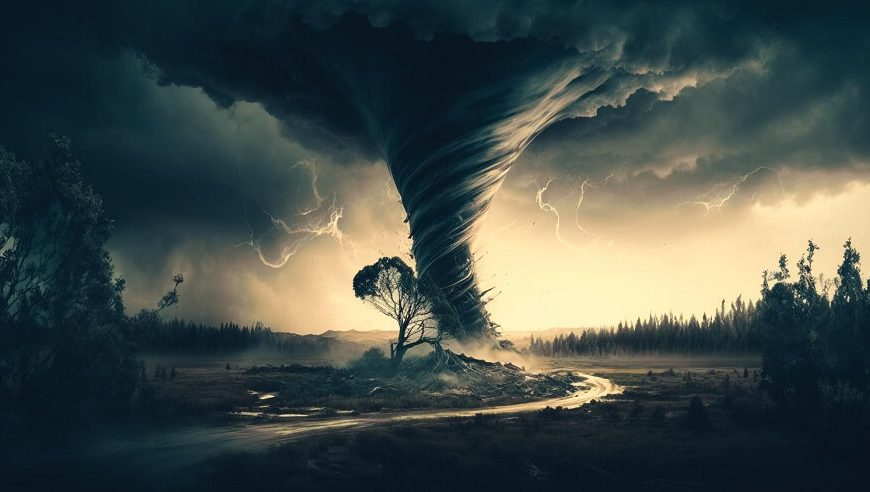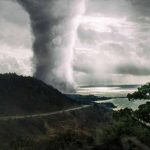Exploring Tornadoes: Facts, Causes, Effects, Safety, and Educational Insights
Young and old brains alike have long been fascinated by natural calamities. Tornadoes stand out as some of the most exciting and possibly catastrophic natural phenomena among these amazing occurrences. In this blog, we will dig into the fascinating realm of tornadoes and look at various fascinating facts that will capture kids’ and students’ attention and offer insightful information on the causes, impacts, and safety precautions associated with these potent natural events.
What is a Tornado?
Let’s start with the fundamentals. An air column that extends from a thunderstorm to the ground and rotates quickly is called a tornado. Due to its strong winds and the debris it transports, it resembles a swirling funnel-shaped cloud and may be highly damaging. Tornadoes may range in size from tiny ropes to enormous wedges, and their wind speeds can reach up to 300 mph! The strongest storms in nature, or “tornadoes,” may uproot trees, flip automobiles, and demolish structures. Without much forewarning, they strike without waiting for the wind to quiet or the air to calm down. Using a Doppler radar, meteorologists may see an impending tornado.
Causes and Effects of Tornadoes:
A complicated interaction of meteorological factors leads to tornadoes. They generally develop during intense thunderstorms when cold, dry air and warm, wet air collide. The atmosphere seems to be spinning horizontally as a result of the direction and speed of the wind changing with height. A tornado can form if a powerful updraft tilts this revolving air from horizontal to vertical. Tornadoes may have severe repercussions. They have the power to fling heavy items with enormous force, crush buildings, and uproot trees. Tornadoes can also result in fatalities and leave a path of devastation in their wake.
According to atmospheric science or meteorology, an area experiences a combination of warm, dry, chilly, and wet air before a tornado forms. They usually begin with a thunderstorm, which develops when the chilly, dry air meets the warm, wet air as it climbs above. When the wind is at a greater altitude, it has more speed along with an alternate path than the wind at a lower height, and this storm intensifies. The storm is tilted and rotated by a process known as wind shear. More warm air is drawn into the “storm cloud” as it intensifies.
Meanwhile, a tiny wall cloud forms in the chilly air below. Within the wall cloud, a funnel cloud develops, reaching the ground and causing the air to rotate. A tornado is created when the funnel cloud and this revolving air on the earth’s surface collide. The tornado vanishes when the updrafts begin to lose strength. Most tornadoes endure less than 15 minutes, swiftly forming and dissipating.
Facts About Tornadoes:
- Diverse Shapes and Sizes:
- The Enhanced Fujita Scale:
- Tornado Alley:
- Short Lifespan:
- The Fastest Wind Speeds:
- The Tri-State Tornado:
- Underground Tornadoes:
- Sound of a Tornado:
- Tornado Watches vs. Warnings:
- Tornado Outbreaks:
- Tornado Myths:
Tornadoes can resemble several vortices or even a stovepipe in addition to the well-known funnel shape. They can range in size from a few feet to a mile wide.
The Enhanced Fujita (EF) scale, which spans from EF0 (weakest) to EF5 (strongest), is used to categorise tornadoes. Estimated wind speeds and the damage they cause serve as the basis for categorization.
Because of the interaction between warm, moist air from the Gulf of Mexico and chilly, dry air from Canada, the central region of the United States, which is sometimes referred to as “Tornado Alley,” is particularly prone to tornadoes.
When compared to other types of natural catastrophes, tornadoes are very brief. While most only last a few minutes, some might linger for several hours.
During the tornado outbreak in Oklahoma in 1999, the mind-blowing 318 mph wind speed was the highest wind speed ever recorded in a tornado.
The Tri-State Tornado, the worst storm in American history, wreaked unimaginable havoc on Missouri, Illinois, and Indiana in 1925.
Heavy things, such as homes and cars, can be lifted by tornadoes and dropped at another location. Because of this phenomenon, there are certain misconceptions concerning “underground tornadoes,” however they are untrue.
A tornado is frequently characterised as making a continuous roaring sound, like a goods train. The wind and debris spinning inside the tornado produce this recognisable sound.
While a tornado warning indicates when a tornado has been detected on the ground or by radar, a tornado watch is issued when the atmospheric conditions are favourable for tornadoes to occur.
Both isolated tornadoes and outbreaks of them can happen. A tornado outbreak occurs when several tornadoes originate in a limited amount of time and in a particular location.
Some common myths about tornadoes include the need to equalise pressure by opening windows, which is harmful and useless, and the risk of taking cover beneath overpasses owing to flying objects.
Top 10 Tornado Safety Tips:
- Stay Informed:
- Designate a Safe Area:
- Practice Drills:
- Mobile Homes:
- Driving Precautions:
- Stay Low:
- Avoid Windows:
- Protective Headgear:
- Emergency Kit:
- Stay Calm:
Watch the weather reports, especially if there is a chance of heavy thunderstorms.
Choose a secure area in your house, perhaps a basement or storm cellar. Select a low-floor internal room without windows if they are not accessible.
To guarantee that everyone in your family is aware of where to go and what to do in the event of a tornado, practice tornado drills.
Have a strategy in place in case severe weather threatens where you reside in a mobile home so that you may seek out stronger refuge.
If you’re driving and a tornado is approaching, do not seek shelter under highway overpasses. Instead, drive at right angles to the tornado’s path to get out of its way.
If you end yourself outside, lay down in a low-lying spot, like a ditch, and cover your head to avoid being hit by flying objects.
Avoid windows while seeking refuge indoors since flying debris might shatter glass.
Consider wearing a helmet to protect your head from potential collisions.
Keep a first aid kit, non-perishable food, water, and a torch in your emergency bag.
In a tornado, maintaining composure is crucial. Pay attention to weather reports and heed local authorities’ instructions.
Tornadoes’ Educational Value:
Even though they undoubtedly cause damage, tornadoes also present special educational opportunities. Studying tornadoes aids in the development of enhanced warning systems, forecasting accuracy improvements, and a better understanding of severe weather patterns. Tornadoes offer a fascinating real-world setting for learning for students interested in meteorology, atmospheric science, or emergency management.
Powerful natural phenomena like tornadoes attract people and call for respect. Everyone, especially kids and students, must understand the causes, impacts, and safety precautions related to tornadoes. People may stay safe and aware in the face of these breathtaking but possibly hazardous phenomena by equipping themselves with knowledge. Keep in mind the top 10 tornado safety suggestions, maintain your interest in the science of tornadoes, and keep discovering the marvels of nature.
In conclusion, tornadoes have a fascinating and significant universe of their own. Tornadoes are a reminder of nature’s unbridled power because of their fascinating funnel forms and potentially destructive effects. By educating kids and students about these various tornado facts, talking about their causes and impacts, and emphasising tornado safety, we may encourage them to approach these awe-inspiring natural phenomena with a balance of curiosity and care. So, remember these tips the next time a storm threatens, and be safe while admiring the amazing forces that have shaped our world.
















